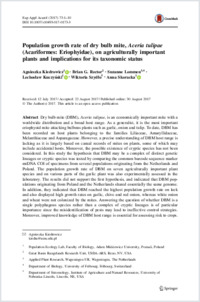Population growth rate of dry bulb mite, Aceria tulipae (Acariformes: Eriophyidae), on agriculturally important plants and implications for its taxonomic status
- Kiedrowicz, Agnieszka Population Ecology Lab, Faculty of Biology, Adam Mickiewicz UniversityPoznañ, Poland
- Rector, Brian G. Great Basin Rangelands Research Unit USDA-ARS, Reno, USA
- Lommen, Suzanne T. E. Applied Plant Research, Wageningen UR, Wageningen, The Netherlands - Department of BiologyUniversity of Fribourg, Switzerland
- Kuczyński, Lechosław Population Ecology Lab, Faculty of Biology, Adam Mickiewicz University, Poznañ, Poland
- Szydło, Wiktoria Department of Entomology, Institute of Agriculture and Natural Resources, University of Nebraska-Lincoln, Lincoln, USA
- Skoracka, Anna Population Ecology Lab, Faculty of Biology, Adam Mickiewicz University, Poznañ, Poland
-
01.09.2017
Published in:
- Experimental and Applied Acarology. - 2017, vol. 73, no. 1, p. 1–10
English
Dry bulb mite (DBM), Aceria tulipae, is an economically important mite with a worldwide distribution and a broad host range. As a generalist, it is the most important eriophyoid mite attacking bulbous plants such as garlic, onion and tulip. To date, DBM has been recorded on host plants belonging to the families Liliaceae, Amaryllidaceae, Melanthiaceae and Asparagaceae. However, a precise understanding of DBM host range is lacking as it is largely based on casual records of mites on plants, some of which may include accidental hosts. Moreover, the possible existence of cryptic species has not been considered. In this study the hypothesis that DBM may be a complex of distinct genetic lineages or cryptic species was tested by comparing the common barcode sequence marker mtDNA COI of specimens from several populations originating from the Netherlands and Poland. The population growth rate of DBM on seven agriculturally important plant species and on various parts of the garlic plant was also experimentally assessed in the laboratory. The results did not support the first hypothesis, and indicated that DBM populations originating from Poland and the Netherlands shared essentially the same genome. In addition, they indicated that DBM reached the highest population growth rate on leek and also displayed high growth rates on garlic, chive and red onion, whereas white onion and wheat were not colonized by the mites. Answering the question of whether DBM is a single polyphagous species rather than a complex of cryptic lineages is of particular importance since the misidentification of pests may lead to ineffective control strategies. Moreover, improved knowledge of DBM host range is essential for assessing risk to crops.
- Faculty
- Faculté des sciences et de médecine
- Department
- Département de Biologie
- Language
-
- English
- Classification
- Biological sciences
- License
-
License undefined
- Identifiers
-
- RERO DOC 305614
- DOI 10.1007/s10493-017-0173-3
- Persistent URL
- https://folia.unifr.ch/unifr/documents/305983
Statistics
Document views: 93
File downloads:
- pdf: 163
